Election year: Transatlantic public opinion and Ukraine
A public opinion survey in France, Germany, Italy, the United Kingdom and the United States - in collaboration with Davide Angelucci (Unitelma Sapienza) and Gianluca Piccolino (University of Florence).
By Aspen Institute Italia & LAPS-Laboratorio Analisi Politiche e Sociali – Università di Siena
We live in a time of polycrisis, to borrow the term first popularized by the former President of the EU Commission, Jean-Claude Juncker, in 2016, to characterize a period in which “various challenges – from the security threats in our neighborhood and at home, to the refugee crisis, and to the UK referendum – have not only arrived at the same time. They also feed each other, creating a sense of doubt and uncertainty in the minds of our people.” Since 2016, this situation has gotten even worse, adding to the list of challenges the global COVID-19 pandemic, the war in Ukraine and last, but not least, the Israeli-Hamas conflict.
In the context of multiple and mutually overlapping crises, the year 2024 adds a further element of complexity: the coincidence of several election rounds in more than 64 countries worldwide and the European parliamentary elections that, altogether, will bring to the polls almost 64% of the world population. This inevitably implies that, in many countries, these crises and alternative ways to address them, will become a source of political controversy, which is usually called, in political science jargon, a wave of increasing politicization.
Transatlantic relations are, among others, the most exposed to such a risk of politicization, given the nature of the issues at play on both aisles of the Atlantic. The American elections, with the likely competition between the incumbent President, Joe Biden, and the controversial figure of Donald Trump might, potentially, represent an existential turning point in Transatlantic relations, if a would-be Trump administration should translate into policies many of the proposals and claims aired so far both in public and in private. The European parliamentary election might also represent a drastic turning point in the European landscape if the traditional coalition between Socialists and the European People’s Party that has dominated the European scene for decades is either downsized or altogether overthrown in favor of a more right-wing oriented coalition, including the conservative party family and possibly extreme right groups.
This is the political context in which the Aspen public opinion survey was fielded in February 2024 in the Big Four European countries – France, Germany, Italy and the United Kingdom – plus the United States. The aim of this report is to offer a fresh view of the state of play of public opinion on issues related to Transatlantic relations, the Ukraine war, and the Israeli-Hamas conflict.
The survey was also designed to offer food for thought on the state of public opinion in five of the seven members of the G7 that, from January 2024, is run by the Italian presidency.
A rich set of questions included in this survey cannot be covered in a single report. This study focuses on the main threats perceived by public opinion in the five countries, the state of Transatlantic relations, with a special focus on Ukraine and its potential evolution.
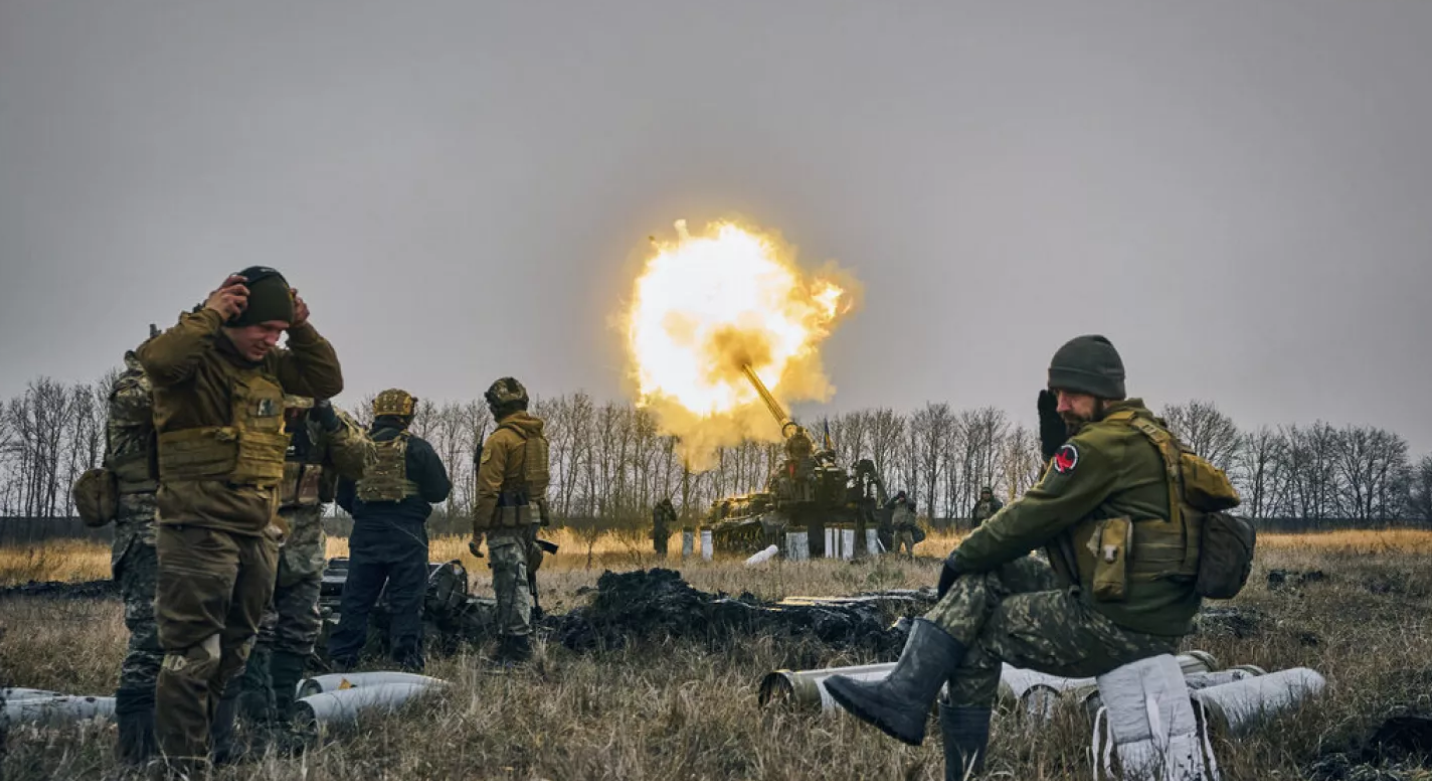
Methodological note
This report presents the results of a public opinion survey conducted by the Laboratory for Political and Social Analysis of the University of Siena on behalf of Aspen Institute Italia among 6,450 adults in five countries (France, Germany, Italy, the United Kingdom, and the United States) between February 21 and March 1, 2024 on the online platform IdSurvey. The sample was selected from an opt-in online panel owned and managed by CINT. The countries’ samples consist of 874 individuals in France, 1,218 in Germany, 1,502 in Italy, 1,479 in the United Kingdom, and 1,377 in the United States, and they can be considered as representative of the national population in terms of gender, age group, area of residence, and educational level, based on parameters of the adult population in the five countries. The survey was conducted using the self-administered Computer-Assisted Web Interviewing (CAWI) method. In instances where the total does not reach 100% or deviates by +/-1, it could be because of rounding, multiple responses, or excluding “don’t know” or “not stated” answers. This report was authored by Davide Angelucci and Gianluca Piccolino, coordinated by Pierangelo Isernia. The survey fieldwork was directed by Rossella Borri.
1. International threats and feelings
The perceptions of various crises and phenomena exhibit several similarities but also significant differences among the five countries analyzed in this study. The majority of respondents in all five countries identify the economic situation as a major security threat. While terrorist attacks, climate change, and the war between Ukraine and Russia are generally perceived as threats by a substantial majority of respondents, there are still notable exceptions. In the United States, climate change and the war between Ukraine and Russia are perceived as threats by less than 50% of the respondents, while the threat of a terrorist attack is much lower in Germany and Italy than in the other three countries. France has the highest perception of terrorist threats. A considerable influx of immigrants and refugees into their respective countries is perceived as a threat by the majority of respondents in Germany, France, and the United States, and by slightly less than 50% in the UK and Italy. Opinions on the conflict between Hamas and Israel, as well as on diseases and pandemics, show a divided public opinion in the five countries. Interestingly, tensions between China and the US are widely considered a major threat in the US (60%), a pattern found in previous surveys over the years, while a much lower percentage of respondents in all European countries share this view. Finally, a potential war between China and Taiwan is considered a relevant threat by no more than 40% of respondents in any country.
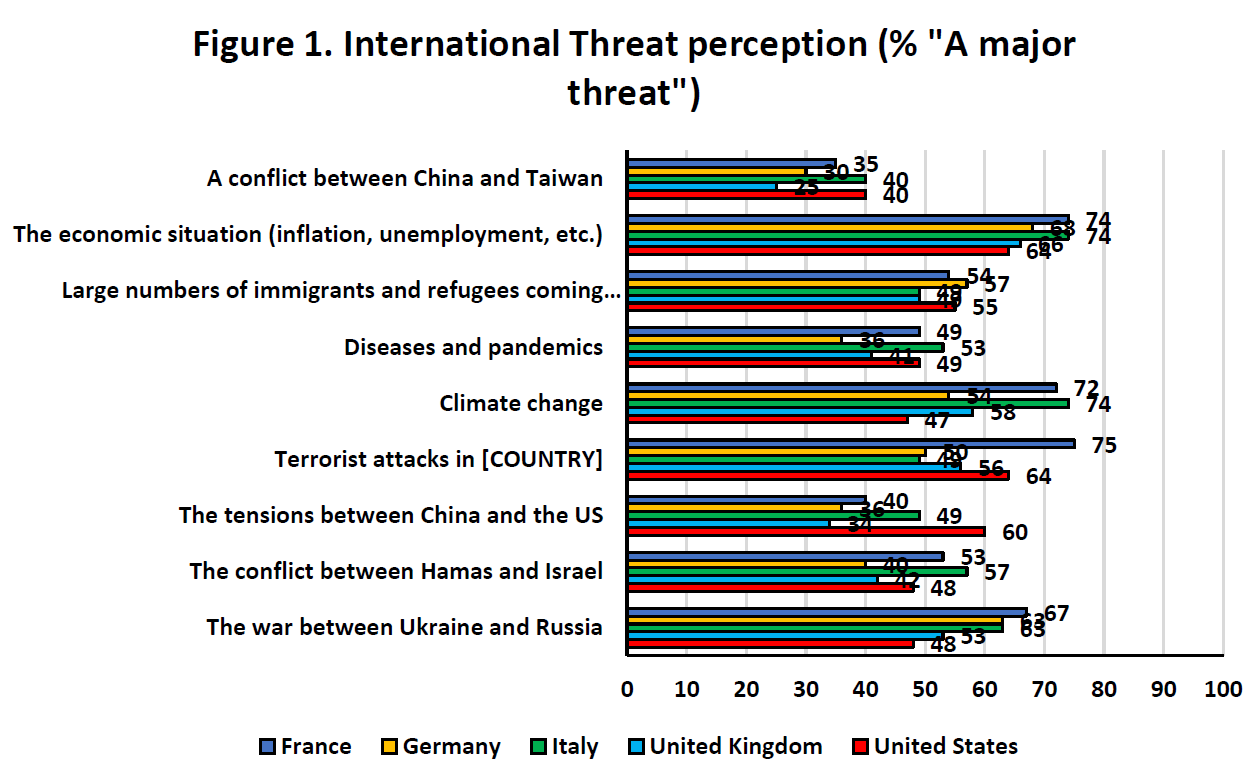
Figure 2 reports the feelings toward a set of institutions and countries directly involved in various international crises; only the European Union manages to achieve a score above 50 on a scale of 0 to 100, although this threshold is only slightly surpassed in each country. Feelings toward the United Nations, NATO, and Ukraine show a division between the United States and the United Kingdom, where they receive an average score of above 50, and the other three countries, where their popularity falls below 50. Sentiments toward Israel reveal a clear divide between the United States and Europe. In the US, feelings toward Israel are slightly above 50 on a 0-100 scale, whereas in all European countries, support for Israel is considerably lower. Finally, feelings toward the Palestinian Authority, China, Russia, and Hamas are all below the 50% threshold, with Hamas and Russia being the least popular in all countries.
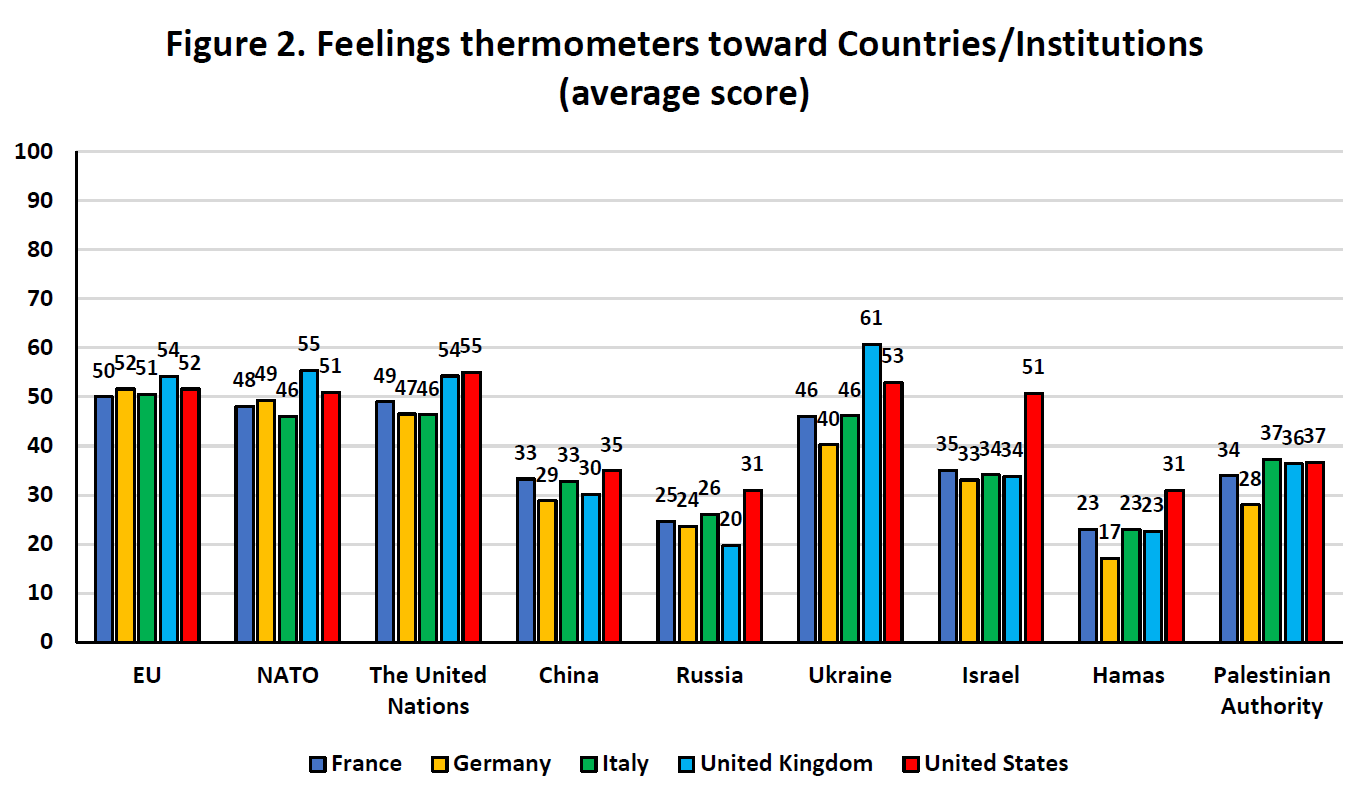
A similar pattern is found when we look at the sentiments of major political leaders, as shown in Figure 3. Volodymyr Zelensky achieves a noteworthy level of popularity in the United Kingdom (average score of 57), slightly below 50 in the United States and France (48 and 46, respectively), and considerably lower scores in Germany and Italy. US President Joe Biden enjoys a higher level of popularity in the United States (45) than in European countries, particularly Italy (34). However, in contrast with the US, where the Trump average thermometer scale is 49 and Biden is 45, the latter remains more popular than Donald Trump in all European countries. Ursula von der Leyen’s popularity is relatively consistent, hovering just above or below the average score of 40 in all five countries. The political figures on which a stark division is found between the United States and Europe are Donald Trump and Benjamin Netanyahu. In the US, their respective scores are 49 and 44 points on the thermometer scale, while in the four European countries, their popularity drops dramatically to levels of 30 points or below. Xi Jinping and Vladimir Putin experience notably low average levels of popularity, especially the latter.
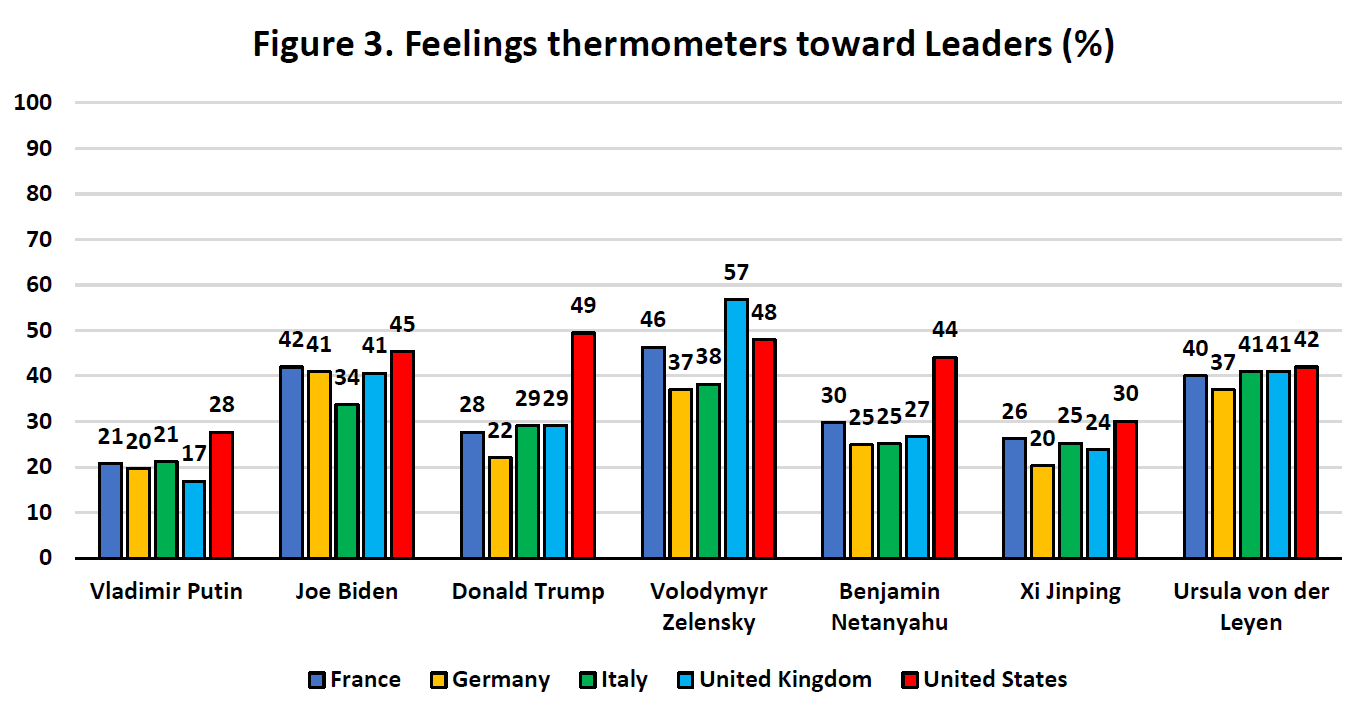
2. International alliances
As far as Transatlantic relations are concerned, the survey returns a complex picture, with signs of strain together with the confirmation of a stable relationship. The survey asked about the partnership between Europe and the US, in which respondents were presented with three alternatives: strengthening, maintaining at the current level, or reducing the partnership between Europe and the United States in security and diplomatic affairs. The most commonly selected option in each country was to maintain the current level of the relationship. In the United States, the United Kingdom, and Germany, those in favor of strengthening the relationship exceeded those inclined toward a more independent approach. Conversely, in France and Italy, the opposite trend was observed, with more respondents favoring a more independent stance rather than advocating a stronger relationship.
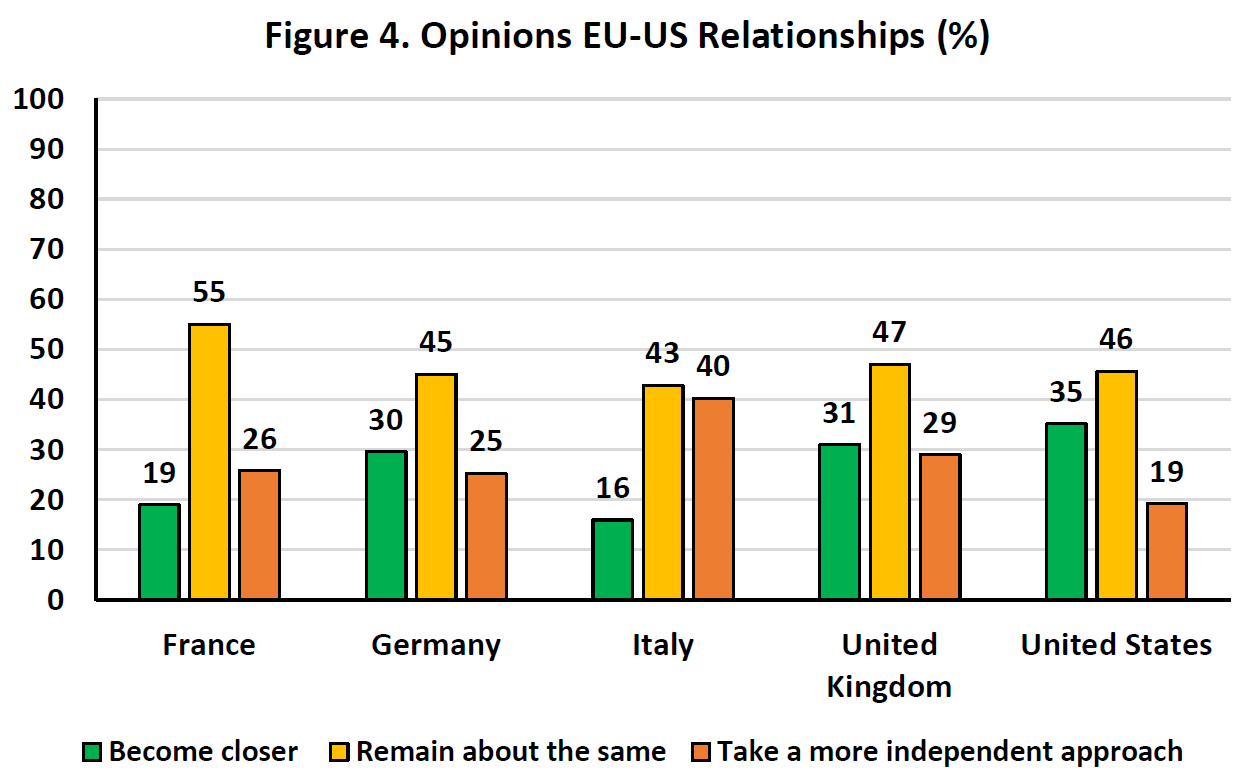
When considering the future of international relationships, a noticeable divide emerges once again between the United States and Europe. The preference among European public opinion is for a multipolar world, with stronger support for this idea in Germany, Italy, and the United Kingdom compared to France. The second-most selected option is a world where only China and the US stand as superpowers, followed by a scenario in which the EU also joins their ranks. Very few Europeans desire a global order in which the United States continues to be the sole superpower. Conversely, among American citizens, the most selected option is to keep the US as the only global superpower (38%), followed by the preference for a multipolar world (35%).
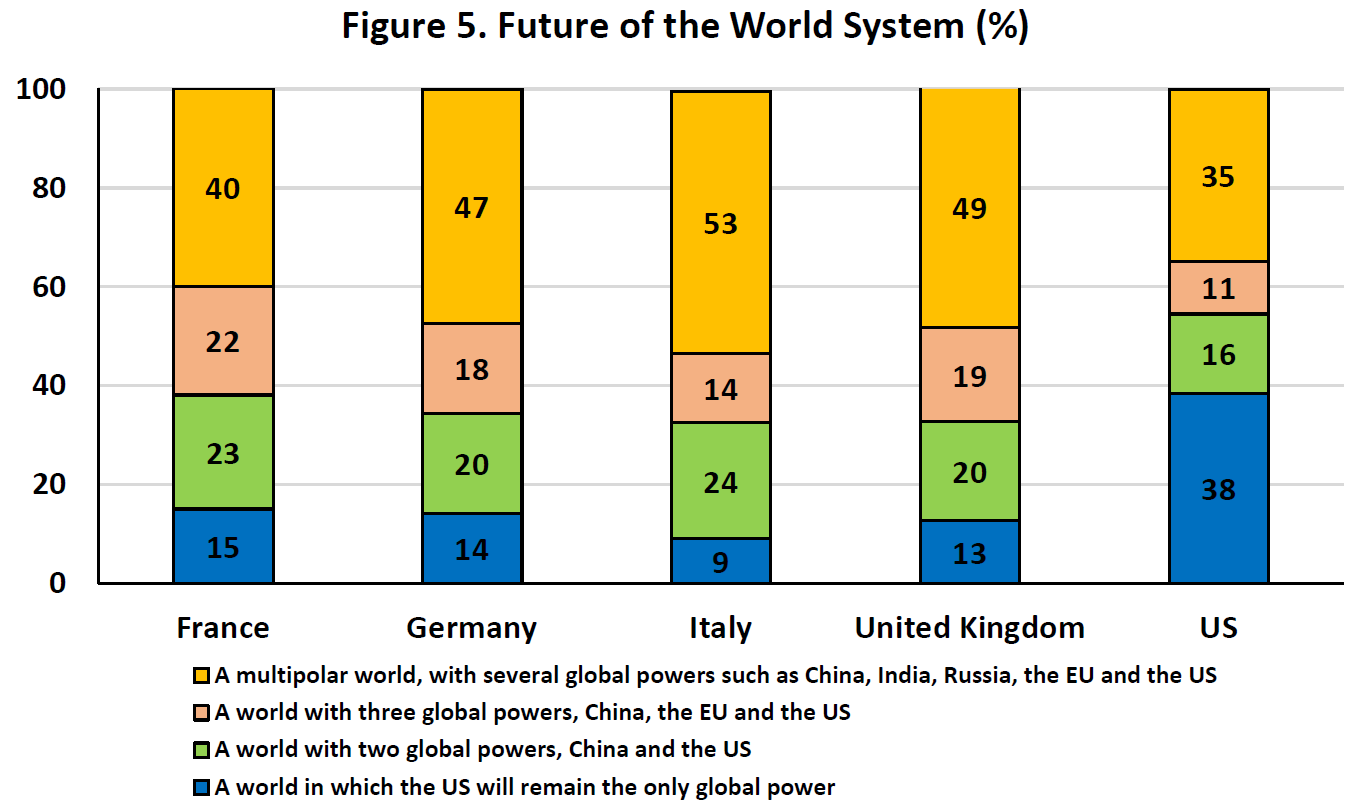
With regard to NATO, a significant majority of respondents in each country deemed the alliance essential for their country’s security. The highest percentage was recorded in the United Kingdom (83%), whereas the lowest was recorded in Italy (68%).
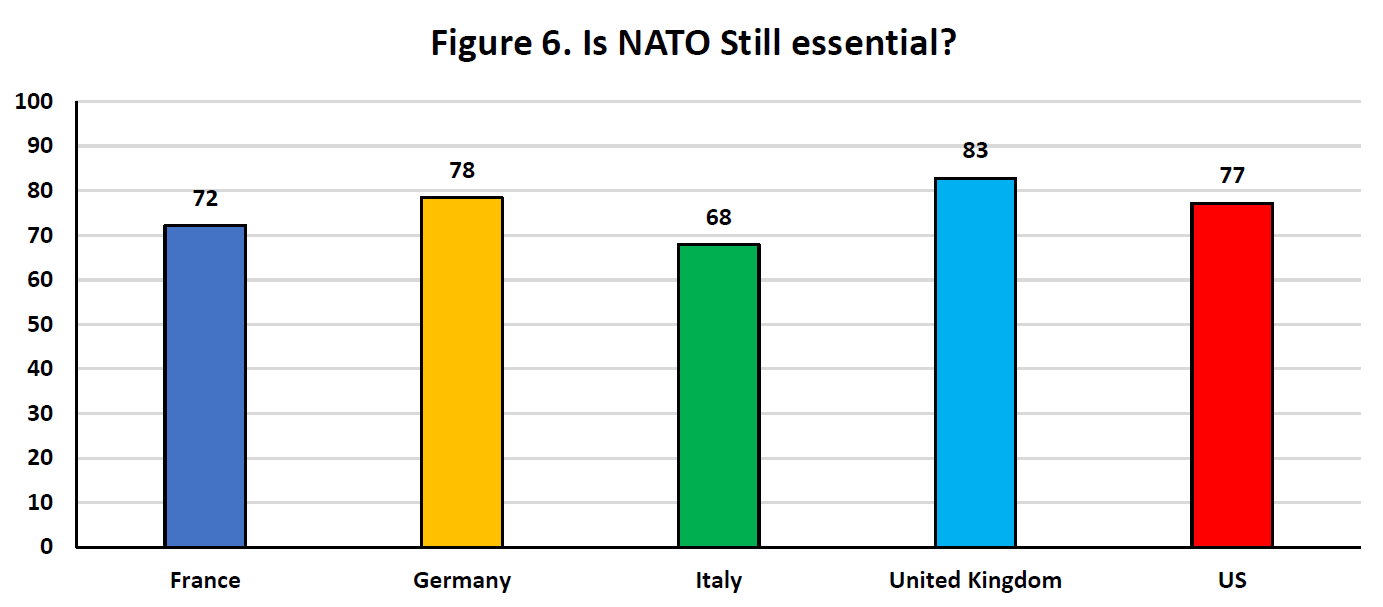
When it comes to the preference for a common defense structure in European countries, the picture among the four countries becomes more complex and nuanced. No more than a tenth of respondents (ranging from 4% in the UK to 12% in Italy) are in favor of a European army fully independent from NATO. Similarly, support for the current NATO structure does not receive substantial support (between 16% and 19%). These percentages are not significantly different from those who wish for a national security policy independent of both NATO and the EU (ranging from 17% in the UK to 23% in Germany). A plurality of respondents in Germany, Italy, and France wish to have an EU common army within NATO. Not surprisingly, in the UK, many respondents would prefer a greater role for the EU and the UK within NATO, without advocating a common European army.

Finally, the stances on military expenditures reveal a nuanced picture among the five countries (Figure 8), hinting at the potential problems that this issue raises again in Transatlantic relations. In Italy, only 17% of respondents believe that military expenditure should be increased, with 52% supporting the option of keeping such expenditure at the current level, and almost one third of respondents expressing a preference for a decrease of military funds. In contrast, 50% of British respondents favor an increase in the military budget, while only 7% wish for a decrease. In the other three European countries, the share of respondents supporting an increase and those favoring military expenditure at the same level are relatively close. A comparatively smaller proportion of respondents in these countries express a preference for reducing their military budgets.
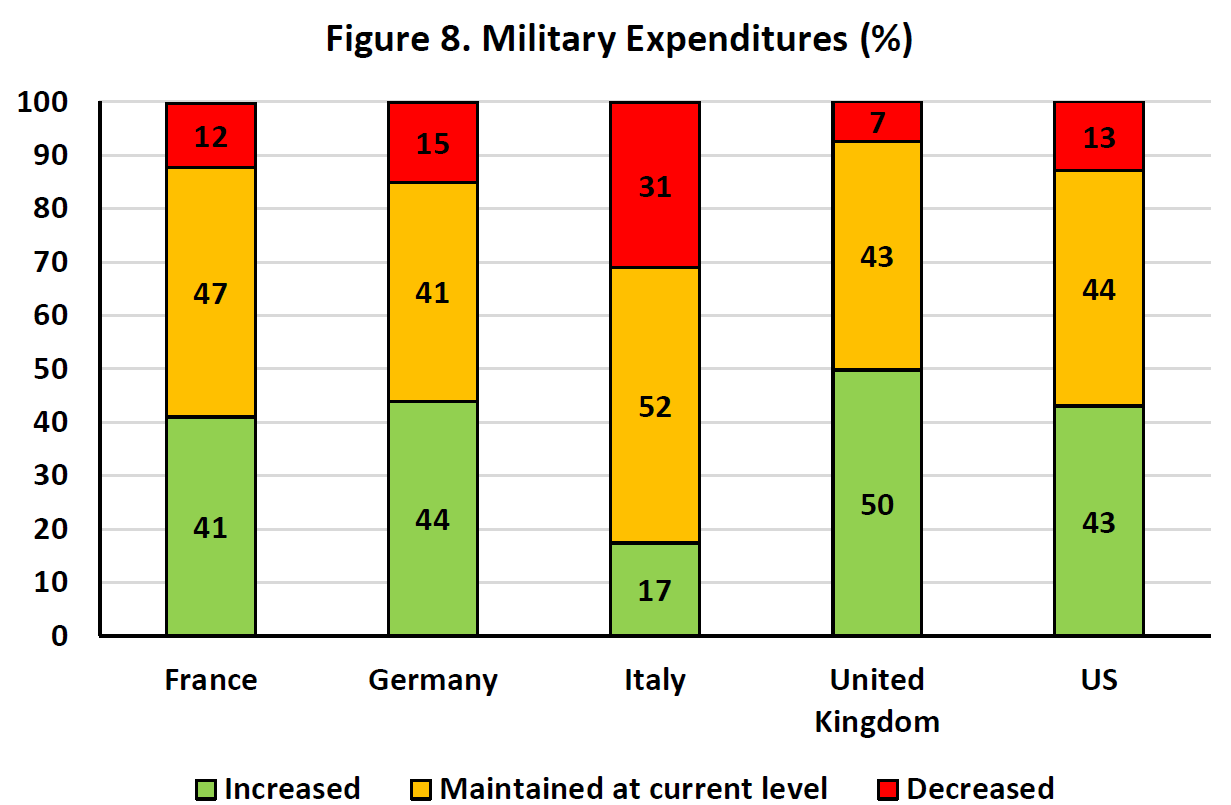
3. European integration
The issue of European integration is, of course, at the center of public and political debate, especially within a profoundly unstable international context that has reopened the issue of integration in the fields of foreign policy and defense. Citizens’ preferences for integration into Europe in a series of policy areas in the four European countries were measured through two questions. The first asks about satisfaction with the level of integration achieved thus far (i.e., retrospective evaluations). The other asks how much integration would be desirable in the future (i.e., prospective evaluations).
The results of these two questions are diverse and highlight significant differences in citizens’ preferences and differences articulated both across countries and across different policy areas. The first general finding concerns the policy areas where the percentage of those who believe that European integration is “too little” is relatively higher (Figure 9). In this regard, social and welfare, defense and security, and environmental policies stand out. Obviously, there are differences between countries. In France, Germany, and Italy, a relatively high proportion of respondents think that social and welfare policies are not sufficiently integrated (this is particularly the case in Germany and Italy, where an absolute majority of respondents think so). The position of British citizens is decidedly more nuanced; here, just over a third of the sample thinks that integration in this policy area is too small.
Also, in relation to defense and security policy, France, Germany, and Italy show a large percentage of respondents in each country believing that there is too little integration in this policy area (percentages hover around 46-47%). By contrast, in the United Kingdom, the proportion that believes integration in defense is too small is significantly lower. Public positions on integration in the field of migration policies also varies. Italy stands out as the only country where an absolute majority of respondents support the idea that integration in this policy area is too small. This position is shared by a significantly lower proportion of people in all the other countries. The same applies to foreign, fiscal, and energy policies. In these policy areas, Italians are more likely to believe that the integration process is still too small; conversely, the proportions recorded in other countries are all lower than those in Italy.
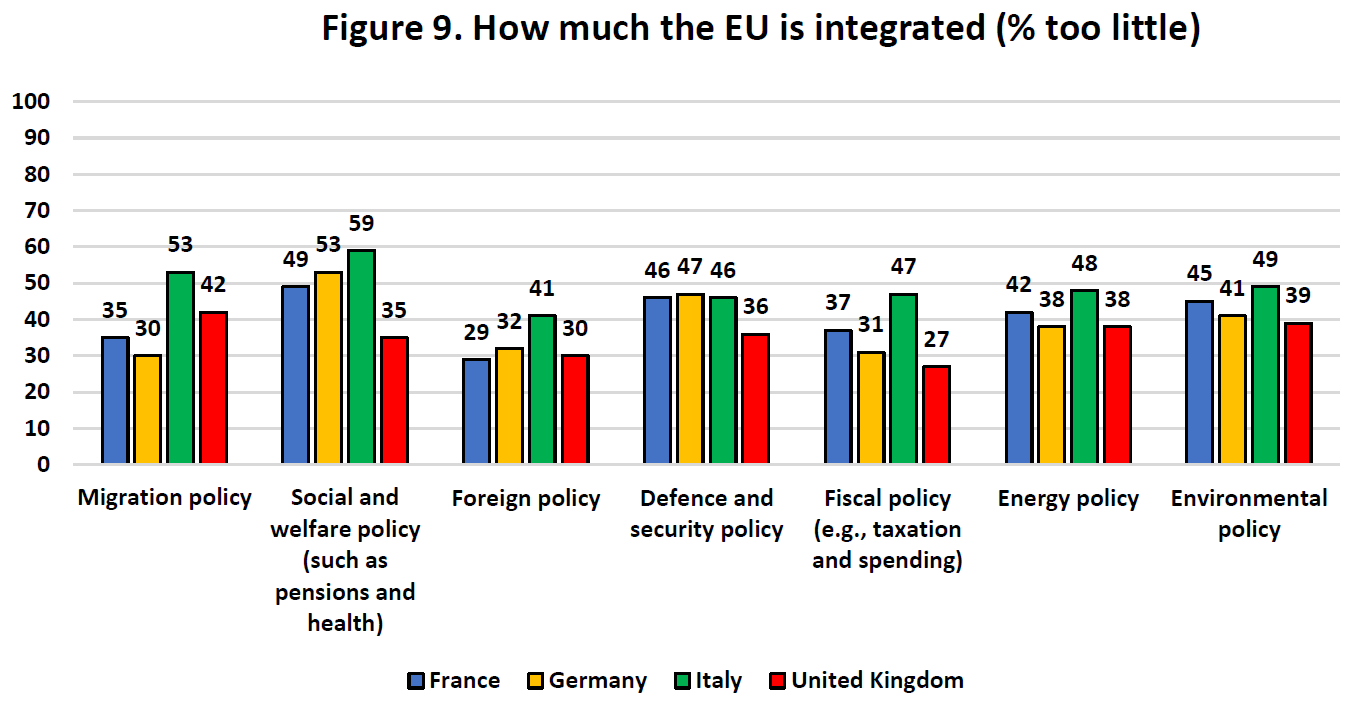
Looking at what Europeans think the future level of integration should be (Figure 10) in different policy areas, the one that receives greater support (on average) is security and defense policy. In three out of four countries (France, Germany, and the United Kingdom), the majority of respondents declared that integration in this area should be strengthened. Italy is the only country in which we registered a relatively lower proportion. It is interesting to note, therefore, that in Italy two opposing perceptions coexist. As noted earlier, almost 50% of Italian citizens believe that integration in the defense area is too small. At the same time, when surveying the future of integration, only a minority of citizens supported the idea of strengthening such a policy.
A similar pattern, with France, Germany, and the UK aligned on one side and Italy on the other, is found in relation to foreign policy, social and welfare policies, energy policy, and the environment, in which the percentage of Italians who believe that European integration should be strengthened is relatively lower than that recorded in other countries. However, an important exception to this pattern is migration policies, in which all countries share a similar orientation, with the relative majority of respondents believing that efforts to strengthen integration in this policy area should be increased.
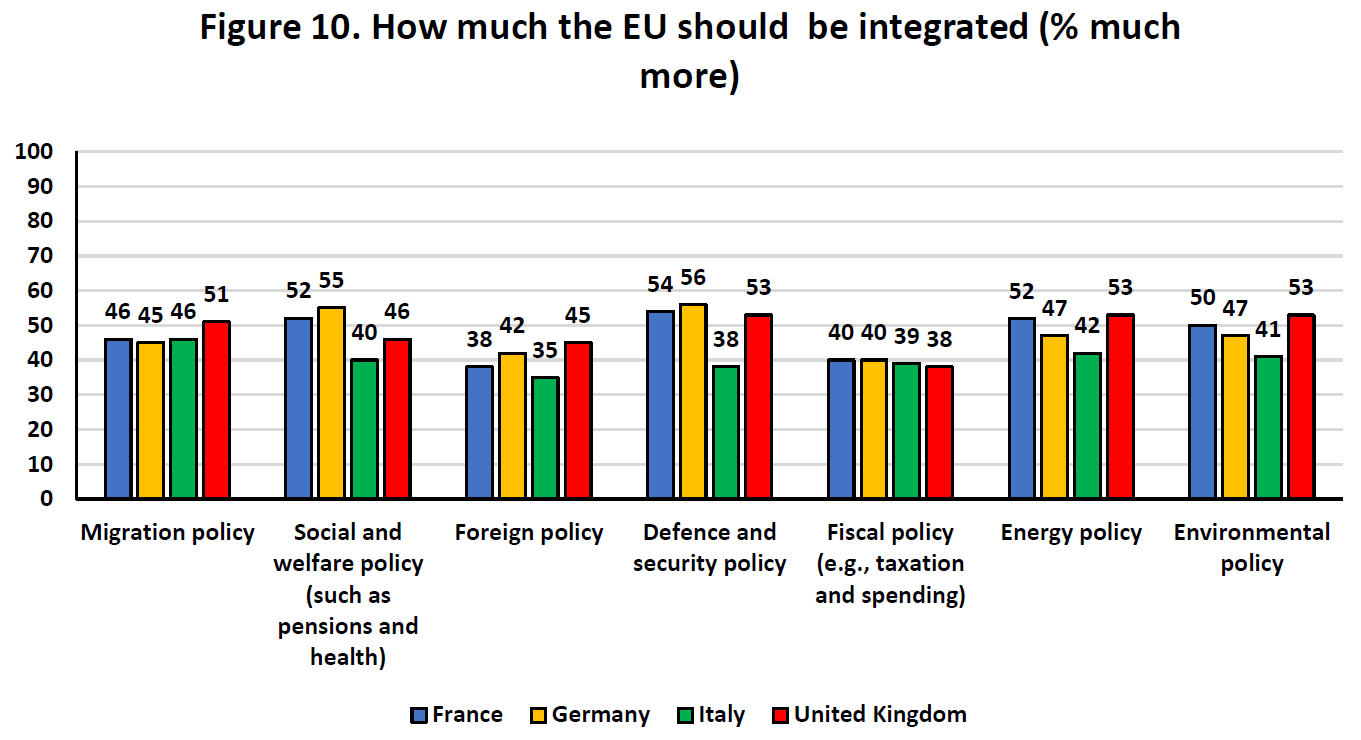
4. War in Ukraine
Two years after the outbreak of the conflict in Ukraine, what are the trends among European and American citizens on this issue? What perceptions do European and American citizens have regarding the escalation of the conflict? What perspectives do they have on the end of the war?
We explored these issues, focusing particularly on the evolution of the Ukrainian war and its possible futures. The first relevant data concerns the public’s stance towards the countries involved (Figure 11). While it is not surprising that most surveyed citizens take the side of Ukraine in general, differences between countries are interesting. In the United Kingdom, citizens overwhelmingly support Ukraine, with less than 10% expressing their support for Russia. At the same time, however, about a quarter of the sample did not take sides. A substantial majority of respondents (though significantly lower than those in the United Kingdom) also side with Ukraine in France and the United States. However, while the proportion of those supporting Russia in France is below 10%, in the US it is above this figure. Cases in Germany and Italy are more interesting and somewhat controversial. In both instances, the percentage of those supporting Ukraine was below 50%, and there was also a notably high percentage of respondents who remained uncommitted. Additionally, it is worth noting that in Germany, we found the highest percentage of those openly siding with Russia.
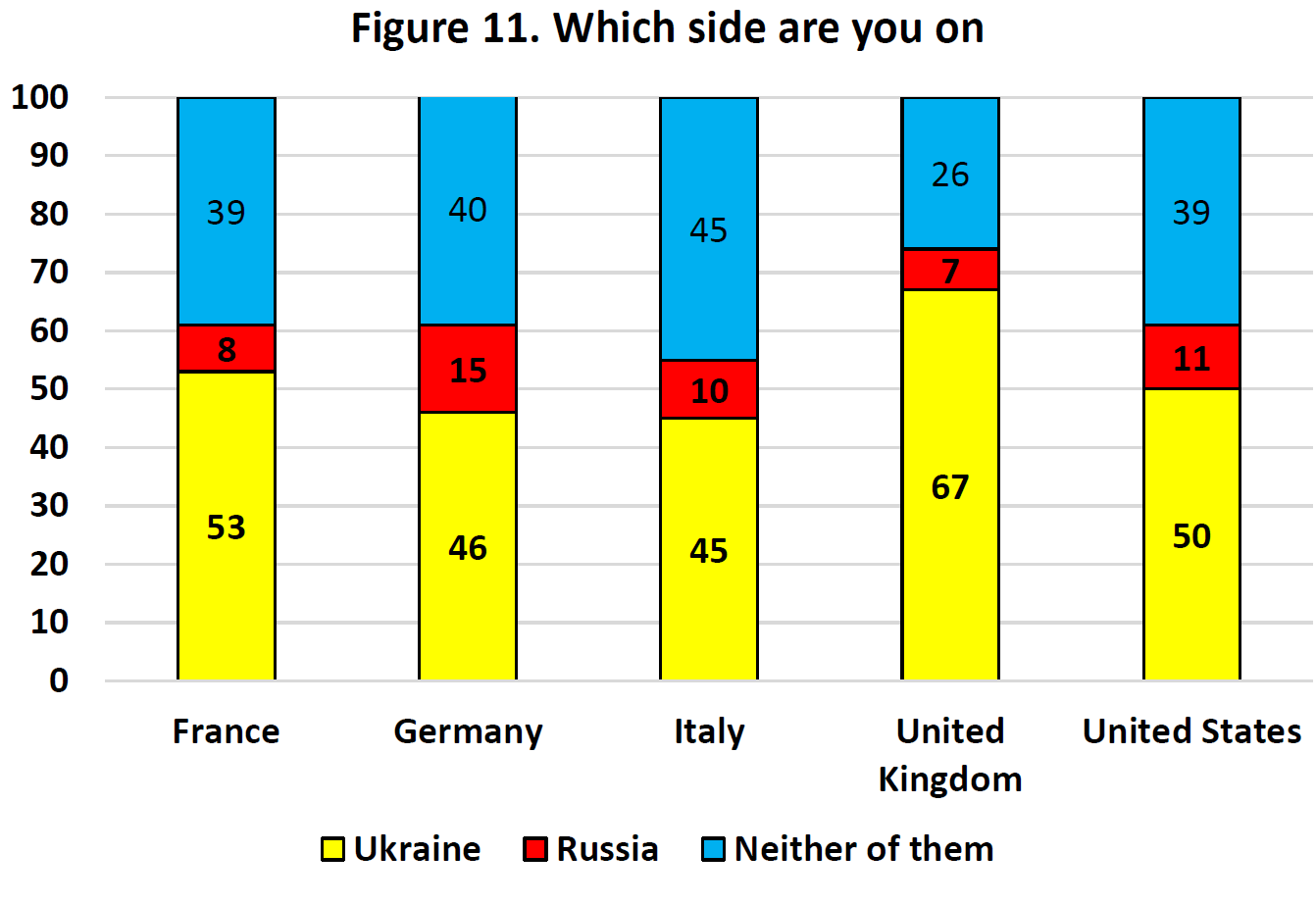
These orientations are at least partially reflected in citizens’ different perceptions regarding the responsibilities for the conflict (Figure 12). In this case, while it is true that in all countries most respondents consider Russia the main culprit, differences between countries are far from negligible. Citizens of the United Kingdom point more strongly to Russia as the country bearing primary responsibility. At the same time, however, a smaller proportion of people blame Ukraine, the USA, the EU, and NATO. However, it is precisely in the United Kingdom that the responsibilities of actors other than Russia are perceived as less relevant. In all other countries, the share of responsibility assigned to Ukraine, the USA, the EU, and NATO is higher. Accordingly, in France, Germany, Italy, and the USA, the share of responsibility attributed to Russia is relatively low. Particularly surprising in this scenario is the case of the US: Here we find the absolute lowest percentage of responsibility attributed to Russia and, at the same time, the highest share of responsibility is equally attributed to Ukraine and the United States.

In parallel with this ambivalence, significant differences emerged among the five countries regarding possible actions to be taken in the Russia-Ukraine conflict (Figure 13). From this perspective, three clusters emerged for the surveyed countries. On the one hand, EU member countries (France, Germany, and Italy) tend to agree on what should be done with Ukraine, and in all three countries the majority of the public is opposed to Ukraine joining NATO and the EU, as well as to increasing economic and military assistance to Ukraine. At the same time, pursuing Russian leaders for war crimes and imposing economic sanctions are generally accepted. However, the three countries differ in terms of their use of military force and direct involvement in the conflict. While in all three cases a majority of citizens oppose the possibility of increasing military supplies to Ukraine, this opposition is significantly stronger in Italy than in both Germany and France (where public opinion is divided on sending weapons to Ukraine). Similarly, opposition to sending NATO troops to Ukraine, as well as the belief that it is necessary to avoid getting involved in the conflict, was stronger in Italy than in Germany and France.
A second cluster can be found in British public opinion. We have already seen how British citizens are, in fact, most clearly aligned in support of Ukraine. Moreover, they are also those (partly together with American citizens) who adopted a tougher stance on the Ukraine issue. An absolute majority of British citizens would like to increase economic sanctions against Russia, and about half of the sample supported increasing military supply to Ukraine. About one-third of the respondents would be willing to send their troops as part of a NATO operation in Ukraine (a higher percentage than in other European countries). However, the sample is divided regarding direct involvement in the conflict as well as the feasibility of offering NATO membership to Ukraine. Finally, it is interesting to note that the UK has the lowest percentage of respondents in favor of starting the formal process for Ukraine’s EU membership.
The US stands, in many aspects, somewhere between the EU countries and the UK. The US is more inclined than EU countries to offer NATO membership to Ukraine, but relatively less so than the UK. Similarly, Americans showed a greater willingness than EU countries to increase economic assistance and military supplies to Ukraine, as well as a slightly greater willingness to impose tougher sanctions on Russia. However, in all these cases, the inclination was relatively lower than that recorded in the United Kingdom. Americans, on the other hand, are the most willing to support a NATO military operation in Ukraine, although, as in the UK, the sample is divided regarding the feasibility of getting directly involved in the conflict. Finally, one last piece of evidence concerns Ukraine’s admission to the EU: in this case, American citizens (in line with what was observed for citizens of EU countries) are relatively more supportive of Ukraine’s EU membership than British citizens.
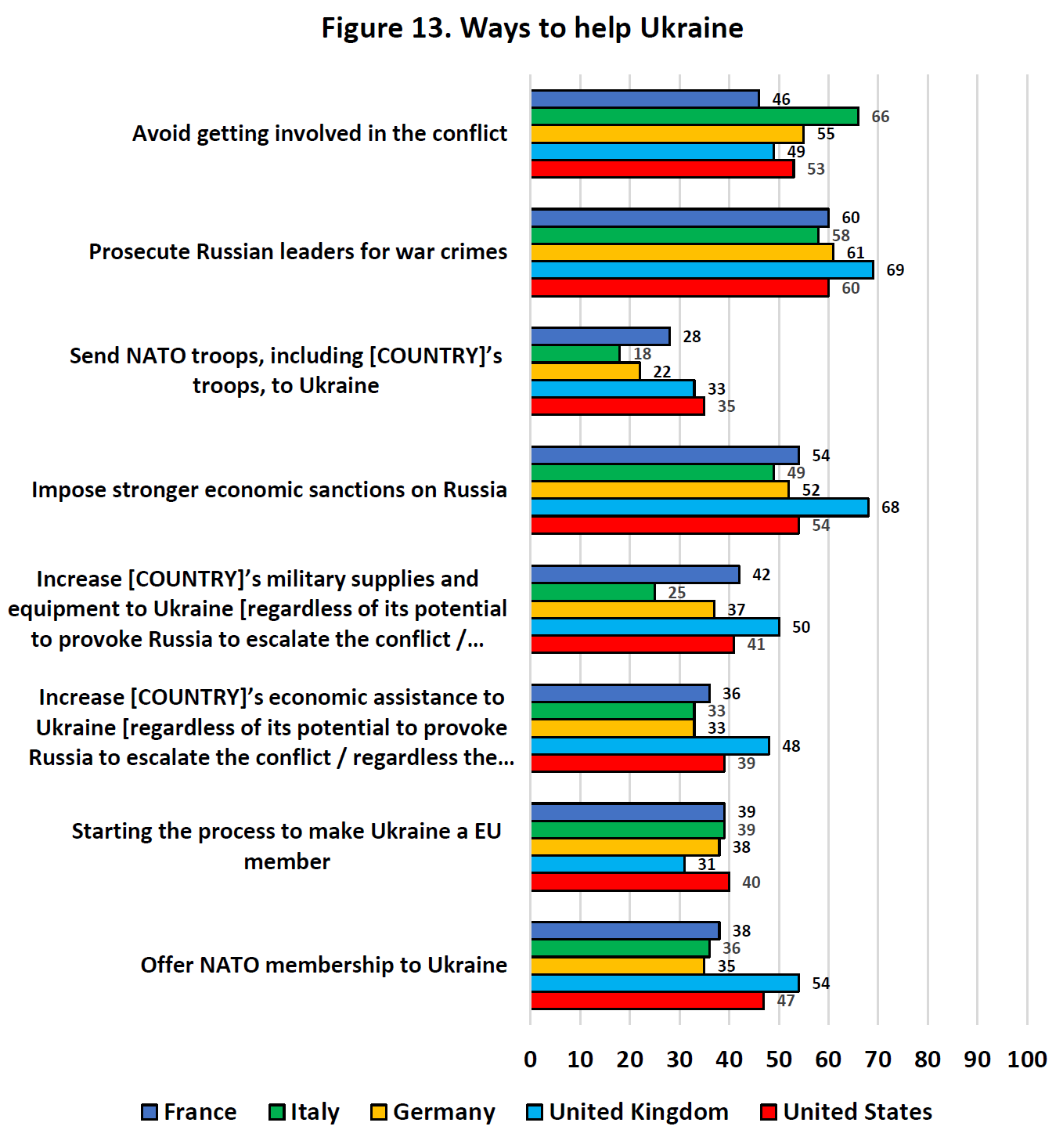
Significant differences also emerged regarding opinions on the end of the war (Figure 14). In France, Germany, and the United Kingdom, a relative majority of respondents believes that there would be no real winner and that the conflict, in the long run, would freeze into a low-intensity conflict. Different opinions have been found in Italy and the US. A plurality of Italians believe that, ultimately, a compromise will be reached. In the US, however, the two most frequent options (essentially of equal weight) are either reaching a compromise or transforming the conflict into a low-intensity conflict, with no real winner. The third most frequent option in all five countries is Russia’s victory, while the percentage of those who believe that Ukraine will ultimately win the conflict is a minority.

However, what victory means is not obvious to experts or, even more so, to the general public. In the survey, we probed in greater detail how victory and defeat were understood by respondents after more than two years of conflict, and in the context of genuine uncertainty about the fate of the war. To decipher the different meanings that people concretely attribute to the idea of victory and defeat, we probed the respondents depending on the way they had answered the question about which side was most likely to win.
On the one hand, among those who believe that Russia will win (Figure 15), substantial differences emerge between the US and Europe. For a relative majority of US citizens, Russia’s victory simply means that Russia keeps only part of the conquered territory, and Ukraine becomes a member of NATO and the EU. For European citizens, a victory of Russia means something quite different; it means that Russia will keep all the conquered territories, while Ukraine will not become a member of NATO and the EU. This is the second option as listed in the United States.
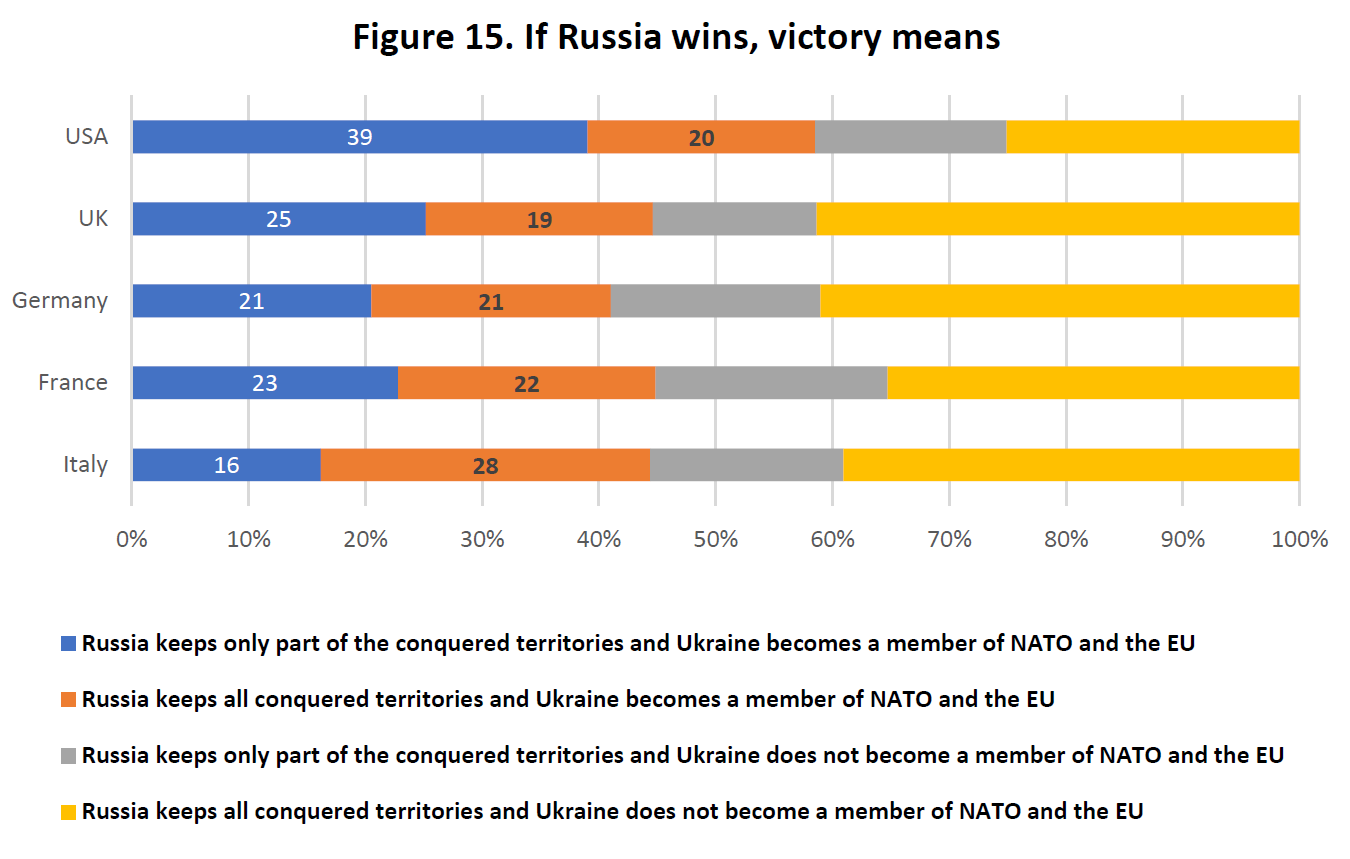
On the other hand, among those who believe that Ukraine will win the conflict (Figure 16), a relative majority in France, Germany, the UK, and the USA believes that Ukraine’s victory should materialize in reconquest of all lost territories and membership in both NATO and the EU. Italy deviates from this pattern, where a relative majority considers the sole reconquest of territories by Ukraine (without it becoming a part of NATO and the EU). This option is also the second-best option in Germany, the UK, and the USA, but not in France (where the reconquest of all territories without entry into NATO and the EU is preferred over the partial reconquest of lost territories but with membership in both NATO and the EU).
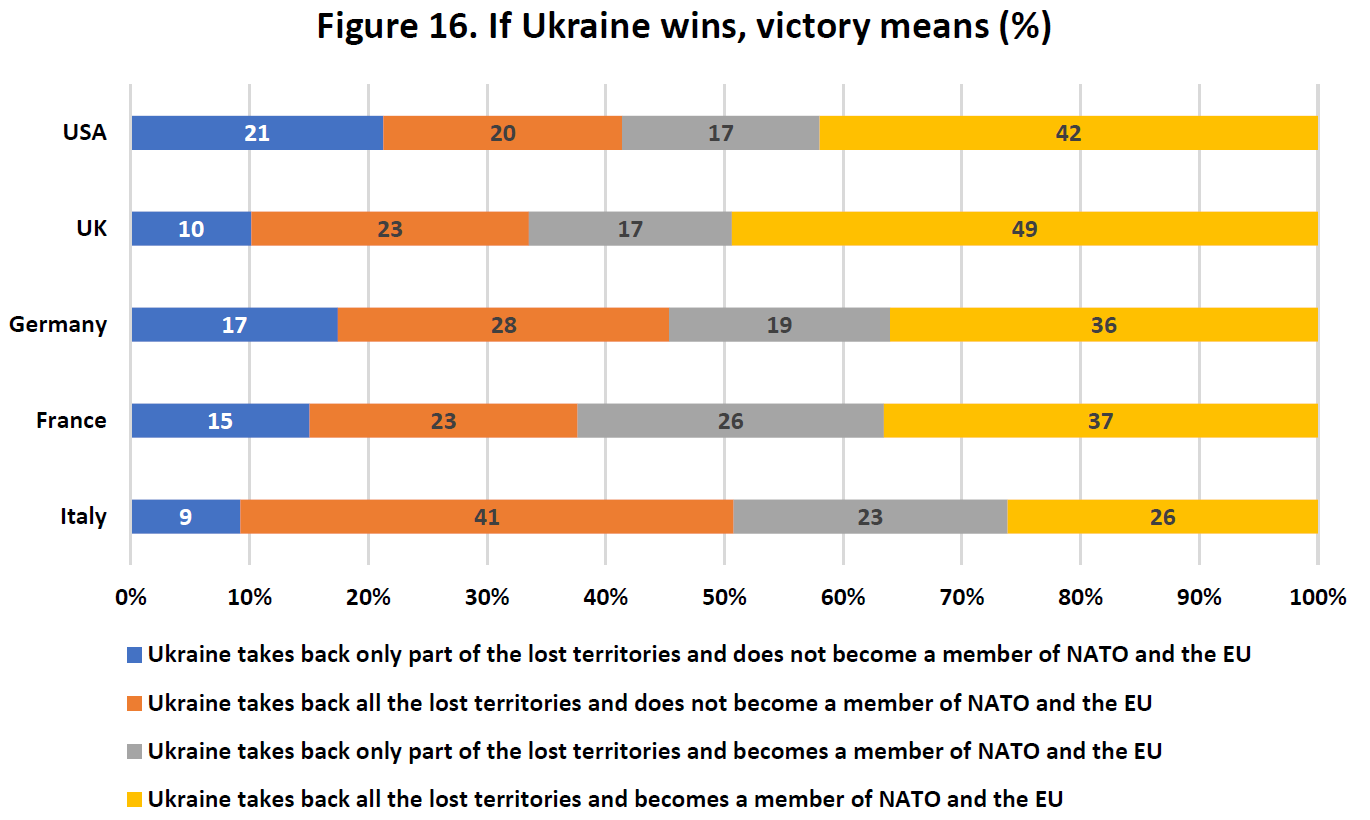
Finally, among those who see compromise as the most likely solution, opinions are substantially divided in Italy, France, and Germany between two options (Figure 17) that trade off land for membership. For some, an acceptable compromise is one in which Ukraine cedes territories to Russia, but in return becomes a member of NATO and the EU. For others, if Ukraine regains control of some of its territories, it should commit to remaining neutral. On the other hand, in the United Kingdom and the United States, the prevailing idea is that compromise implies that Ukraine, while losing all its territories so far occupied by Russia, becomes a member of both the NATO and the EU.
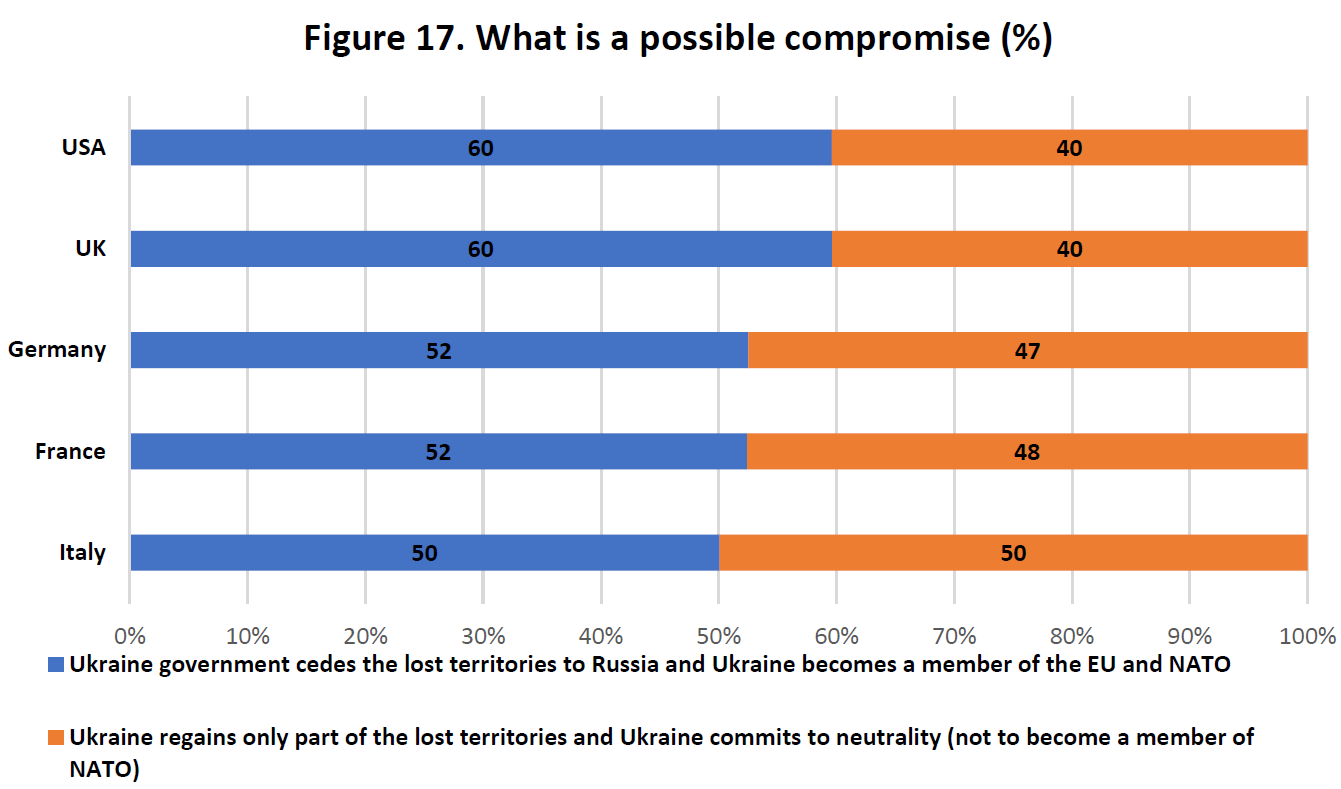
Conclusion
This report comes at a particularly delicate moment for the relationship between Europe and the United States, on the eve of an important electoral cycle on both sides of the Atlantic. It provides a complex and nuanced picture of the present state of opinion on many topical issues. Three main conclusions are worth highlighting.
The first is that while on many issues there is a divide between the US and European countries, and the Israeli-Hamas conflict is one of them, many more differences do exist among the European countries, including gaps on Ukraine and other issues between the UK and the three large continental countries. This fractured and fragmented landscape does not project an optimistic prognosis for the future state of transatlantic relations. Since public opinion plays an important role in the way political leaders position themselves on many issues, it is possible that the incoming electoral period might exasperate, if not sheerly inflame, an already divided political constellation of opinions.
The second conclusion concerns Ukraine. Gone is the time in which solid majorities were ready to side with Ukraine during the war. With the exception of the United Kingdom, where support for Ukraine appears to remain solid, in most of the other countries, including the US, support for the war and for helping Ukraine is, to say the least, controversial. We can expect that in an electoral period in which costly political choices are set on the back burner, the Ukraine war will become a political issue to be handled with care by all parties and their candidates, especially on the center-left of the political spectrum.
The last point concerns European attitudes toward a stronger European defense and security policy. The picture is confused, with positive and negative tones. On the one hand, it is clear that, in part as a consequence of the war itself, support for a stronger role of EU institutions in the defense realm is majoritarian. In all countries, a more cohesive defense posture among European countries is appreciated across the political spectrum. Perhaps even more importantly, such a greater role for the EU does not seem to come at the expense of NATO. In line with the prevalent mood for decades – to have it “both ways” – a stronger and even a more independent role for the EU is seen mostly in the NATO framework. Public opinion is not keen on details, but the direction most preferred is clear. On the other hand, however, one should notice that the implications of this choice are not always fully considered. For example, on the issue of military expenditure, while substantial pluralities in all European countries support an increase in military expenditure, figures are not overwhelming and, in the case of Italy, are definitely lower than in the other three European countries.
